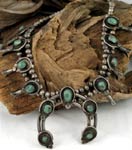Classic Southwest Indian Design

One of the most well known of all Southwest Indian jewelry designs is the squash blossom necklace. However, its roots lie deep in non-Indian culture and history. It became traditional after the arrival of Europeans, when Navajo silversmiths adopted the crescent-shaped “naja” seen on the iron ornaments on the horse bridles of the Spanish Conquistadors in the late 1500s and early 1600s.
At first, these ornaments were either captured or traded and they soon graced the necks of the local Indian populace. Eventually, they were reproduced in various metals and were proudly displayed during ceremonials. Since most ceremonials were related to the agricultural cycle, the naja, therefore, was associated with crop fertility.
The earlier acquired najas were most certainly hung around the owner’s neck by a simple thong. But once silver beads came into fashion around 1880, the naja was displayed in its more traditional form. The first beads were large, non-ornamental and round from which more complicated, fluted and oval designs, developed. In fact, early Navajo and Zuni beads were originally Spanish-Mexican trouser and jacket ornaments, fashioned to resemble the pomegranate, a common Spanish decorative motif. Altough early Navajo “squash blossom” beads show a similarity to the Mexican ornament and the pomegranate it is doubtful that the Navajo attempted to depict this blossom in his bead style.
The Navajo word for the “squash blossom” simply means “bead that spreads out”. It’s possible the name was a mistranslation between English, Spanish, and one of the Southwest Indian languages, or perhaps someone thought the shape of the beads looked like squash blossoms at some point. However, the necklace design is not a traditional stylized depiction of squash blossoms in any Southwestern Indian culture.
The squash blossom necklace serves as a reminder of the close interaction between the Pueblo and Navajo Indians since the mid 1800s. The necklace itself is Navajo but adopted by the Zuni, who in the 19th century, incorporated the use of turquoise inlay patterns on each of the blossoms.





